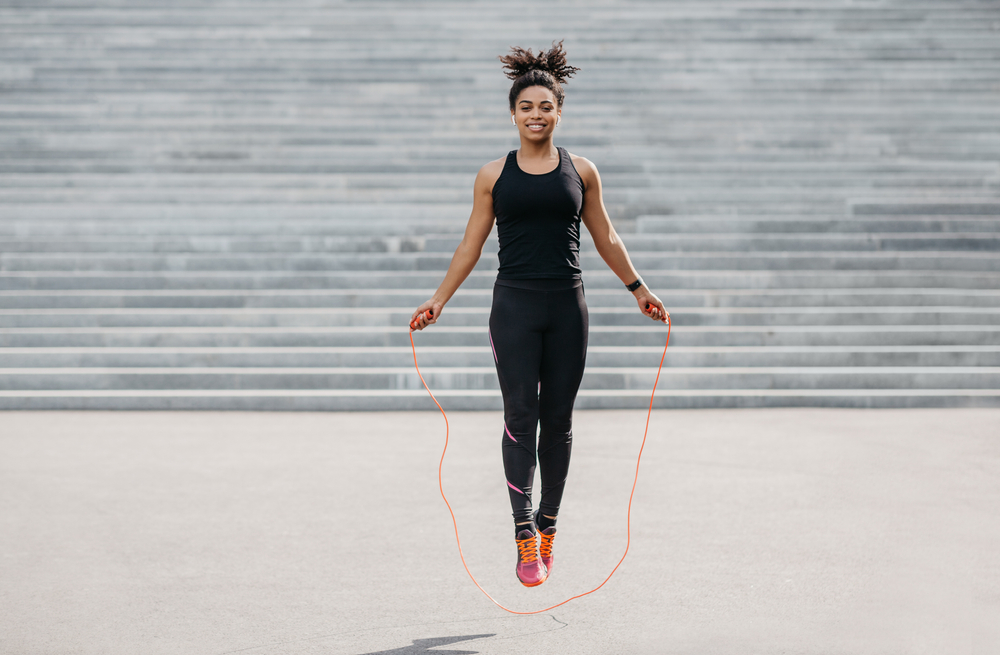Remember jumping rope on the playground? That simple activity you enjoyed as a kid turns out to be one of the most powerful brain-boosting exercises you can do. While most people pick up a jump rope thinking about cardiovascular fitness or weight loss, they’re getting an incredible mental upgrade without even realizing it.
The humble jump rope – portable, affordable, and deceptively simple – creates a perfect storm of conditions for enhancing brain function. From boosting memory and focus to protecting long-term cognitive health, those rhythmic bounces do far more than just work up a sweat.
The coordination challenge rewires neural pathways
Jump roping requires a unique combination of skills that creates the perfect brain-training environment. Your brain must coordinate the timing of your jumps, control the rotation of your wrists, maintain spatial awareness of the rope, and keep your balance – all simultaneously and continuously.
This complex coordination challenge forces your brain to create new neural pathways and strengthen existing ones. Unlike simple, repetitive exercises like running on a treadmill, jumping rope constantly engages your brain in problem-solving and adaptation.
Think about the first time you tried jumping rope after years away from it. You likely missed jumps, whipped the rope into your shins, and couldn’t establish a rhythm. But with practice, these movements became smoother as your brain built dedicated neural circuits for this specific activity.
This neural adaptation extends beyond just getting better at jumping rope. The enhanced connectivity between different brain regions improves your overall coordination and ability to learn other complex physical skills. Your brain becomes more adaptable and responsive, benefiting everything from typing speed to driving skills.
The brain-body connection strengthens with every jump
Each time your feet leave the ground and return during jumping rope, your brain receives and processes information about your body’s position in space – a sense known as proprioception. This constant feedback loop between brain and body strengthens the neural pathways responsible for body awareness and movement precision.
Strong proprioception might seem relevant only for athletes, but it actually underpins many everyday activities. Better body awareness improves posture, reduces injury risk, and even enhances fine motor control for tasks like writing or using tools.
The rhythmic nature of jumping rope also engages a neural mechanism called “bilateral coordination” – the communication between the left and right hemispheres of your brain. When both sides of your body must work in synchronized harmony, the corpus callosum – the bridge between brain hemispheres – gets a significant workout.
This improved communication between brain hemispheres has far-reaching effects, potentially enhancing everything from problem-solving to emotional regulation. The more efficiently your brain hemispheres can share information, the better your brain performs across nearly all domains.
Blood flow to the brain increases dramatically
Your brain is an energy-demanding organ, requiring a constant supply of oxygen and nutrients to function optimally. Jumping rope dramatically increases blood flow throughout your body, including to your brain, delivering performance-enhancing fuel right where you need it.
This flood of fresh, oxygenated blood to your brain creates both immediate and long-term benefits. In the short term, you’ll experience enhanced alertness, faster reaction times, and improved cognitive processing speed – effects that can last for several hours after your jump rope session.
Over time, this repeated increase in cerebral blood flow stimulates the formation of new blood vessels in the brain, a process called angiogenesis. More blood vessels mean better nourishment for brain cells and more efficient removal of waste products – essentially upgrading your brain’s infrastructure.
The improved vascular network also creates cognitive resilience. If one blood vessel becomes compromised due to aging or other factors, your brain has plenty of backup pathways for delivering vital nutrients. This vascular redundancy helps protect against cognitive decline and may reduce the risk of stroke.
BDNF levels surge after jumping sessions
One of the most exciting brain effects of jumping rope involves a protein called Brain-Derived Neurotrophic Factor (BDNF), often described as “miracle-gro” for your brain. Vigorous, rhythmic exercise like jumping rope triggers a significant increase in BDNF production.
This powerful protein stimulates the birth of new neurons (neurogenesis) – something scientists once thought impossible in adult brains. BDNF also promotes the formation of new connections between existing neurons and protects brain cells from stress and damage.
The BDNF boost from jumping rope has profound implications for learning and memory. Higher BDNF levels correlate with improved ability to acquire and retain new information. After a jump rope session, your brain enters a heightened state of plasticity – becoming temporarily more receptive to learning and forming stronger memories.
This biological response helps explain why studying after exercise often feels more productive. The post-exercise BDNF surge creates an optimal window for absorbing and retaining information. Some forward-thinking schools have even implemented jump rope programs before challenging academic subjects, harnessing this biological advantage.
Stress hormones rebalance through rhythmic jumping
Chronic stress and the resulting hormone imbalances can wreak havoc on brain function, impairing memory, reducing focus, and even causing physical changes to brain structures. Jumping rope offers powerful stress-relieving benefits that help protect your brain from these harmful effects.
The rhythmic nature of jumping rope has a meditative quality that helps lower cortisol levels – your primary stress hormone. The predictable, repetitive motion combined with focused attention on the present moment creates a state similar to moving meditation, breaking the cycle of rumination and worry.
At the same time, jumping rope stimulates the release of endorphins, your body’s natural mood elevators. These neurochemicals create the famous “runner’s high” – a state of reduced pain perception and increased feelings of wellbeing that can last long after your workout ends.
This neurochemical rebalancing creates optimal conditions for cognitive performance. With lower cortisol and higher endorphins, your brain operates more efficiently – improving everything from creative problem-solving to analytical thinking.
Brain inflammation decreases with regular jumping
Low-grade chronic inflammation in the brain has emerged as a key factor in cognitive decline and neurodegenerative diseases. Regular aerobic exercise like jumping rope helps combat this inflammation through multiple mechanisms.
Each jump rope session triggers the release of anti-inflammatory compounds that circulate throughout your body, including your brain. These natural anti-inflammatories help counteract the pro-inflammatory effects of stress, poor diet, and environmental toxins.
Additionally, the increased heart rate from jumping rope helps flush inflammatory proteins from your brain more efficiently. Think of it as an internal cleaning system – the faster circulation helps remove waste products that would otherwise accumulate and cause inflammation.
Over time, this anti-inflammatory effect creates a healthier brain environment, potentially reducing the risk of conditions like Alzheimer’s disease and other forms of dementia. While no single exercise can completely prevent these conditions, jumping rope creates a powerful protective buffer against the inflammatory processes that contribute to them.
Attention and focus sharpen with jumping practice
Jumping rope demands sustained attention – lose focus for a moment, and you’ll likely trip on the rope. This requirement for continuous concentration creates a natural training ground for improving attention skills.
Each jump rope session exercises your brain’s prefrontal cortex – the region responsible for executive functions like focus, decision-making, and impulse control. Just like strengthening a muscle, regular activation of this brain region enhances its capability, making it easier to maintain focus in other contexts.
Many people with attention difficulties find that jumping rope provides a uniquely effective form of focus training. The immediate feedback loop – maintaining rhythm or tripping on the rope – helps train the brain to sustain attention more effectively than abstract concentration exercises.
This enhanced attention capacity extends far beyond the jump rope session. Regular jumpers often report improved ability to focus during work or study, enhanced listening skills in conversations, and greater overall mental clarity. The focused state required for successful jumping seems to carry over into other activities.
Sleep quality improves, boosting cognitive recovery
The relationship between sleep and brain function is profound – during deep sleep, your brain consolidates memories, clears out waste products, and performs essential maintenance processes. Jumping rope can significantly improve sleep quality, creating a virtuous cycle of enhanced cognitive recovery.
The physical exertion of jumping rope helps regulate your circadian rhythm, signaling to your body when it’s time to be alert and when it’s time to rest. Regular jumpers often experience faster sleep onset and more consistent sleep patterns.
Additionally, the stress-reducing effects of jumping help quiet the mental chatter that often prevents quality sleep. Lower cortisol levels and reduced anxiety create ideal conditions for your brain to transition into restorative sleep states.
This improvement in sleep quality amplifies all the other cognitive benefits of jumping rope. Better sleep means more efficient memory consolidation, enhanced learning retention, and more effective removal of the metabolic waste products that can impair brain function. Essentially, jumping rope helps your brain make the most of its critical overnight recovery time.
The lifetime brain benefits of consistent jumping
Perhaps most impressive about jumping rope is how it creates both immediate and cumulative brain benefits. A single session provides a short-term boost to cognition, while consistent practice builds lasting changes to brain structure and function.
Regular jumpers maintain better cognitive function as they age, showing slower decline in processing speed, memory, and executive function compared to sedentary individuals. The combination of improved blood flow, enhanced neural connections, and reduced inflammation creates a powerful defense against age-related cognitive changes.
The accessibility of jumping rope makes it particularly valuable as a lifelong brain-boosting practice. Unlike activities that become difficult with age or require special facilities, jumping rope can be adapted to different fitness levels and performed almost anywhere with minimal equipment.
Even short jumping sessions – as little as 10 minutes a day – appear to confer significant brain benefits when performed consistently. This makes jumping rope one of the most time-efficient brain investments available, offering remarkable cognitive returns for a relatively small time commitment.
Next time you pick up a jump rope, remember that you’re doing far more than just working your heart and burning calories. With each rhythmic bounce, you’re giving your brain a comprehensive workout that enhances everything from focus and memory to long-term cognitive health. That simple childhood activity turns out to be one of the smartest things you can do for your adult brain.















